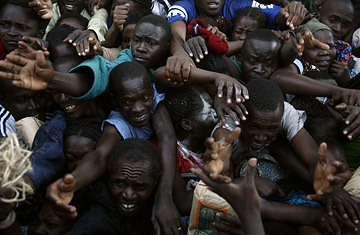| The World's Growing Food-Price Crisis |
 |
 |
 |
| Written by 3K Admin |
| Tuesday, 20 October 2009 16:46 |
|
By Vivienne Walt Wednesday, Feb. 27, 2008 Add this to the list of items that could seriously threaten world peace: food. Rocketing food prices — some of which have more than doubled in two years — have sparked riots in numerous countries recently. Millions are reeling from sticker shock and governments are scrambling to staunch a fast-moving crisis before it spins out of control. From Mexico to Pakistan, protests have turned violent. Rioters tore through three cities in the West African nation of Burkina Faso last month, burning government buildings and looting stores. Days later in Cameroon, a taxi drivers' strike over fuel prices mutated into a massive protest about food prices, leaving around 20 people dead. Similar protests exploded in Senegal and Mauritania late last year. And Indian protesters burned hundreds of food-ration stores in West Bengal last October, accusing the owners of selling government-subsidized food on the lucrative black market. "This is a serious security issue," says Joachim von Braun, director-general of the International Food Policy Research Institute (IFPRI), in Washington. In recent weeks, he notes, he has been bombarded by calls from officials around the world, all asking one question: How long will the crisis last? The forecast is grim. Governments might quell the protests, but bringing down food prices could take at least a decade, food analysts say. One reason: billions of people are buying ever-greater quantities of food — especially in booming China and India, where many have stopped growing their own food and now have the cash to buy a lot more of it. Increasing meat consumption, for example, has helped drive up demand for grain, and with it the price.There are other problems too. The spike in oil prices, which hit $103 per barrel in recent days, has pushed up fertilizer prices, as well as the cost of trucking food from farms to local markets and shipping it abroad. Then there is climate change. Harvests have been seriously disrupted by freak weather, including prolonged droughts in Australia and southern Africa, floods in West Africa, and this past winter's deep frost in China and record-breaking warmth in northern Europe. The push to produce biofuels as an alternative to hydrocarbons is further straining food supplies, especially in the U.S., where generous subsidies for ethanol have lured thousands of farmers away from growing crops for food. "The area used for biofuels is increasing each year," says Nik Bienkowski, head of research at ETF Securities, a commodities-trading firm in London. To make matters worse, global stockpiles of some basics have dwindled to their lowest point in decades. Rice — a staple for billions of Asians — has soared to its highest price in 20 years, while supplies are at their lowest level since the early 1980s, according to the U.S. Department of Agriculture. Meanwhile, the global supply of wheat is lower than it's been in about 50 years — just five weeks' worth of world consumption is on hand, according to the U.N. Food and Agricultural Organization. As always in a crisis, there are winners. The creeping fear that the world might actually run short of food — no longer simply the stuff of sci-fi movies — has led speculators to pour billions into commodities, further accelerating price rises. In a single day in February, global wheat prices jumped 25% after Kazakhstan's government announced plans to restrict exports of its giant wheat crop for fear that its own citizens might go hungry. Jittery officials in India and Egypt are also restricting food exports. "Prices have risen at a much faster rate in the last few months," says Fazlul Kader in Dhaka, Bangladesh, where he coordinates rural projects for the U.N.'s International Fund for Agricultural Development; there, soybean oil alone has shot up 60% in a year. For the world's poorest people, the price spikes are disastrous. AID officials say that millions who previously eked out enough to feed their families can no longer afford the food in their local stores, and are seeking help from relief organizations. "We are seeing a new face of hunger," says Josette Sheeran, executive director of the U.N.'s World Food Program (WFP). "People who were not in the urgent category are now moving into that category." Last month she bluntly told Western donors that WFP will trim its aid programs this year unless it can raise an extra $500 million to cover the rising cost of the food that it now provides to about 73 million people, including many who survive on just 50 cents a day. The U.S. Agency for International Development (AID) — the WFP's biggest donor — said last month it had been forced to cut about $120 million from future aid programs to pay for current commitments. "That money is gone," says Jonathan Dworken, deputy director of AID's Food for Peace program. He says its commodity expenses have soared by 41% in six months. Yet despite the widespread demonstrations, the food crisis has been largely ignored until recently by U.S. and European officials — who pay for much of the world's food aid — partly, says von Braun, "because no one is starving in rich countries." Last October, shortly before food riots began exploding across West Africa, the WFP's director in Mauritania, Gian Carlo Cirri, flew to a donors' meeting in Senegal and warned Western aid officials that "2008 will be a very dangerous year," with rising food prices increasingly liable to hurt middle-class city dwellers, "who are prone to demonstrating." Similarly, von Braun says he has felt "like a Cassandra" in Washington in recent years, as he tried to warn U.S. officials numerous times that a global food crisis was looming. Even now, he says, "the specialists share our sense of urgency, but it hasn't broken out of that circle yet." That could change if food riots begin to threaten the survival of governments. In many poor countries, the protests have been fueled by pent-up anger against authoritarian or corrupt officials, some of whom have earned fortunes from oil and minerals while locals are struggling to buy food. "It's a bad combination," says Alioune Tine, head of a human-rights organization in Senegal. Voters in Pakistan trounced President Pervez Musharraf's party in crucial parliamentary elections last month, in part because many could no longer afford staple foods — and blamed the government. "We are worried about terrorism and those other things, but first we are worried about basic needs," said a 24-year-old nurse in Islamabad, shopping in the capital's busy Aab Para market during election season last month. "People want a person who can fix this problem." Any fix will take time. Several African countries have begun planting high-protein, pest-resistant rice crops, and aid organizations are beginning to hire locals for new job programs to help people pay their food bills. In the poorest parts of Asia and Africa, officials hope that sky-high food prices might lift out of poverty small farmers who have barely scraped by on low crop prices — a hope that would get a big boost if the rich world agreed to cut agricultural subsidies in the current round of trade talks. In parts of Bangladesh, farm workers' wages have doubled in a year, says Kader, the project coordinator in Dhaka. But they too need to buy food. And for most people, food prices are rising faster than earnings. With shelves in Pakistan, Burkina Faso, Senegal and elsewhere stocked with unaffordable food, people might still opt to burn government buildings and attack stores. That, at least, is free. Source: http://www.time.com/time/world/article/0,8599,1717572-2,00.html |
| Last Updated on Tuesday, 20 October 2009 16:49 |


